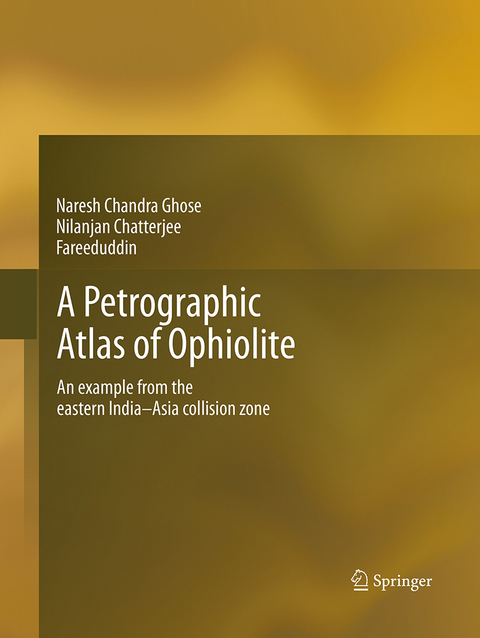
A Petrographic Atlas of Ophiolite
Springer, India, Private Ltd (Verlag)
978-81-322-3492-0 (ISBN)
Prof. N.C. Ghose, born in Uttarpara near Kolkata on 18 June 1940, obtained M.Sc. in 1961 and Ph.D. in Geochemistry in 1964 from Banaras Hindu University, Varanasi, India. He joined Patna University in 1965 and retired as a Professor in 2000. As a fellow of the Alexander von Humboldt Foundation, he pursued research in Gottingen (1972–73) and Karlsruhe (1978–79) on “Experimental Melting of Granite System”. He has determined the Eutectic composition and Temperature in the system “Quartz–Orthoclase–Anorthite” at 4 and 7 kbars (1973), which has wide implication in crustal melting. He extended the melting experiment studies to natural rocks ranging from gneisses and granites from the Darjeeling Himalaya, Chotanagpur gneisses to the migmatites of South Norway (Dypvag). Prof. Ghose has worked in the field of Earth and Environmental Sciences and authored 7 books and published 90 original research papers in peer reviewed journals. His contributions in the fields of Proterozoics of Chotanagpurgneisses, Massif anorthosite of Bengal, Rajmahal basalts and the Ophiolites of Naga Hills are widely acclaimed. He has published original research papers and books on Pollution of chemical, bacteriocidal and radioactive (radon) constituents of River Ganga in the Mid-Ganga Basin (1989), Groundwater Resources of Patna urban conglomerate (1992), Iodine contents of soil–water–plant in the Gangetic Plain of North Bihar (2003), and Synthetic Detergents (surfactants) and Organochlorine Pesticides in the Surface water and Groundwater of the Deltaic region of Bengal (2009), used in the fields of science, medicine, town planning and social work. Dr. Nilanjan Chatterjee received his Ph.D. in Geochemistry from the City University of New York in 1989. His high school and undergraduate education was in India. He is currently employed as a Principal Research Scientist in the Department of Earth, Atmospheric and Planetary Sciences at the Massachusetts Institute of Technology (MIT), Cambridge, USA. He has over 22 years of experience in Electron Probe Micro-analysis (EPMA) and manages the EPMA facility at MIT. He teaches courses related to the EPMA technique and its applications. Dr. Chatterjee has co-authored 40 papers in peer-reviewed earth science journals, 30 meeting abstracts, and a book on thermodynamic database published by Springer. His research interests include igneous and metamorphic petrology and he is currently working on ultrahigh pressure metamorphism and ophiolite emplacement in the Himalayas, high-grade metamorphism in eastern India, Kerguelen Plateau and Antarctica related to Proterozoic-Paleozoic supercontinental break-up and assembly, and the geochemical evolution of the Deccan flood basalts. He has also collaborated in the modeling of hydrous peridotite melting in the mantle wedge. Dr. Chatterjee has reviewed manuscripts for several leading journals and research grant proposals for the National Science Foundation, and has appeared in a BBC documentaryabout flood basalts. Dr. Fareeduddin completed his Ph.D. in Geochemistry from Mysore University and joined Geological Survey of India in 1983. Currently, he works as its Director in Kolkata. As a professional geologist, he has mapped parts of Precambrian terrains of southern and western India and was involved in several mineral exploration projects. He has served the Geological Society of India as its Secretary and Editor of its flagship journal, Journal of the Geological Society of India. He was the convener of the 10th International Kimberlite Conference held at Bangalore between 6th and 11th February 2012. He has about sixty national and international publications to his credit including books on ‘Recent Advances in Earth System Sciences’ and ‘Diamonds and their Source Rocks in India’. He is currently the Editor for the IUGS journal Episodes and Member, International Kimberlite Conference Advisory Committee.
Introduction.- Ophiolite around the Indian Plate Margin.- Geology of the Naga Hills Ophiolite.- Structure and Tectonics of the Naga Hills.- Petrography.- Petrogenesis.
| Erscheinungsdatum | 16.10.2016 |
|---|---|
| Zusatzinfo | 410 Illustrations, color; 67 Illustrations, black and white; XVII, 234 p. 477 illus., 410 illus. in color. |
| Verlagsort | New Delhi |
| Sprache | englisch |
| Maße | 210 x 279 mm |
| Themenwelt | Naturwissenschaften ► Geowissenschaften ► Geologie |
| Naturwissenschaften ► Geowissenschaften ► Hydrologie / Ozeanografie | |
| Naturwissenschaften ► Geowissenschaften ► Mineralogie / Paläontologie | |
| Schlagworte | Convergent Lithospheric Plate • Eastern Indian Plate • Eclogite • Glaucophane Schist • Peridotite |
| ISBN-10 | 81-322-3492-8 / 8132234928 |
| ISBN-13 | 978-81-322-3492-0 / 9788132234920 |
| Zustand | Neuware |
| Haben Sie eine Frage zum Produkt? |
aus dem Bereich


